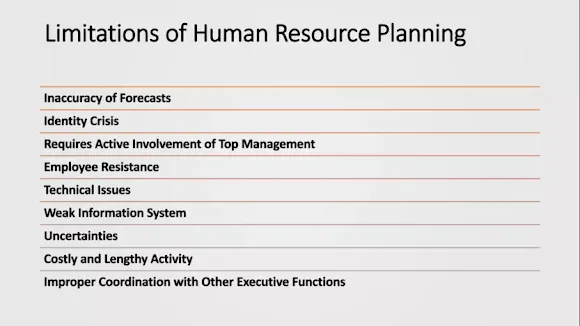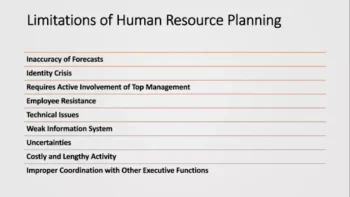Limitations of Human Resource Planning
Understanding the limitations of human resource planning is important for organisations to navigate the challenges and opportunities of organisational behaviour effectively, which they may encounter during the planning phase.
Human resource planning is not always successful; there are some limitations of human resource planning HRP which are as follows:
- Inaccuracy of Forecasts
- Identity Crisis
- Requires Active Involvement of Top management
- Employee Resistance
- Technical Issues
- Weak Information System
- Uncertainties
- Costly and Lengthy Activity
- Improper coordination with Other Executive Functions
- Loss of Balanced Focus
1) Inaccuracy of Forecasts
HR planning involves predicting the supply and demand of human resources. Hence, the efficiency of HR planning is based on the correctness of forecasts, and it cannot always be an accurate process. If the forecast is wrong, then the workforce planning will also not be accurate. The longer the time horizon, the greater the possibility of inaccuracy. Inaccuracy increases when departmental forecasts are merely aggregated without any critical review. It involves forecasting the demand and supply of human resources.
2) Identity Crisis
Sometimes, managers and human resource experts in the organisation cannot clearly understand the entire process of HRP. Due to this, an identity crisis exists. HR planning cannot be effective until the experts clearly understand objectives.
3) Requires Active Involvement of Top Management
Top management should be an integral part of workforce planning. If the top management does not play an active role, the essential resources and assistance required for effective human resource planning cannot be gained in the organisation. Without support and commitment from the top management, human resource specialists find it difficult to obtain vital inputs. Sometimes, the process started with great fanfare but was not sustained due to a lack of patience.
Read More:– Process of Human Resource Planning
4) Employee Resistance
Usually, trade unions oppose staffing planning as they think it will increase the burden of work. They feel that HR planning will increase their workload and regulate them through productivity bargaining. Moreover, employees and trade unions sometimes feel that due to widespread unemployment, people will be available for jobs as and when required, increasing unemployment for unskilled labourers. Employers may also resist human resource planning because of the feeling that it increases the cost of the workforce. Managers and human resource specialists do not fully understand the HR planning process and lack a strong sense of purpose.
5) Technical Issues
Effective HRP is not an instantaneous task. It takes time to be gradually accepted. Newer technologies have to be adapted to compete. Sometimes, complicated technologies are vigorously introduced because competitors are also using them. It cannot be fruitful unless HR personnel identify training needs and the HRP identifies the employees who require training.
6) Weak Information System
The development of successful human resource planning is based on the credibility of the information system. In Indian industries, information systems are still poorly developed; hence, precise and reliable data cannot be collected for effective human resource planning. The human resource information system in most industries has not been fully developed. Therefore, Without reliable data, it is impossible to develop human resource plans effectively.
7) Uncertainties
HRP is not wise to depend entirely on the generalised data collected about the workforce. Seasonal jobs, absent employees, and technological issues are the factors that hamper workforce planning: labour absenteeism, labour turnover, and seasonal employment. Technological changes and market fluctuations are uncertainties that constrain human resource planning. It is risky to depend upon general workforce estimates in the face of dynamic changes in the business environment.
8) Costly and Lengthy Activity
HRP is a costly and time-consuming activity. There is a chance that organisations may not adopt the system as it will increase the cost burden on the organisation. Workforce planning is a time-consuming, lengthy and expensive process. Forecasting and data collection involve a lot of time and cost.
9) Improper Coordination with Other Executive Functions
Usually, the workforce planner does not interact with the manager and is confined to his area of concern. It hampers HR planning. For its effectiveness, HRP should be incorporated with other managerial functions.
10) Loss of Balanced Focus
Usually, focus is given to the quantifiable facet of HR planning, i.e., the number of individuals leaving or joining the organisation. There is too much focus on the quantitative aspect to ensure the flow of employees in and out of the organisation. Such an exclusive focus overtakes the more important dimension, i.e. the quality of human resources. The qualitative part is neglected, including career development, self-esteem, planning skill levels, etc. Such uneven focus impacts the efficiency of HRP.
Skill levels, career planning and development, morale, etc., will likely suffer due to an unbalanced human resource planning approach. Thus, limitations of human resource planning arise both from inherent limitations of forecasting and from human weaknesses.

In recent years, the focus on human resource planning has increased due to the following reasons:
1. Employment Situation
On the one hand, the number of educated unemployed is increasing. On the other hand, there is an acute shortage of various skills. Under-developed countries find that a shortage of talented and skilled workforce is a major obstacle to their industrial progress, and they must import certain skills.
2. Technological Changes
The widespread and rapid changes in production technology, marketing methods and management techniques have profound concerns about redundancies, retraining and redeployment of personnel. Systematic human resource planning helps to solve these challenges.
3. Organisational Change
The size of firms is increasing. The environment of business has become turbulent. Rapid changes in the environment require changes in organisational structure and activities, affecting human resource requirements.
4. Demographic Changes
The profile of the workforce in terms of age and gender requires a wide range of specialised skills. These skills are scarce and problems. New human resource strategies are needed to meet these requirements; education, technical skills, and social background are changing. Such change has significant implications for human resource planning.
5. Shortage of Skills
Organisations have become increasingly complex and arise when employees with these skills leave an organisation.
6. Legislative Controls
The law about working conditions, working hours, weaker sections, women and child labour, casual and contract labour, etc., do not permit management to recruit and fire at free will. Therefore, managers must look ahead and foresee workforce problems with the help of systematic human resource planning.
7. Pressure Groups
Trade unions, politicians and displaced persons try to pressure management for internal recruitment and promotion. They want management to prefer candidates from the local region where the company operates; individuals displaced due to reasons such as development projects or natural disasters, and employment opportunities for the children of current employees, etc.
8. Systems Concept
Systems thinking encourages the interconnectedness of various components within an organisation. It recognises that human resources are a critical component of the overall system. They are not just a separate department but an integral part of the overall system. Information technology stresses planning and enables storing, collecting, and analysing vast amounts of human resources data related to employee performance, skills, and demographics.
9. Lead Time
Longer lead time is required to find, screen, and select qualified candidates and train existing employees to handle new job roles and technologies successfully. It necessitates long-term human resource planning to equip employees with the necessary skills and knowledge.
10. Hiring Costs
Recruitment and training costs are increasing. An Increase in hiring costs encourages organisations to prioritise a cost-effective approach by investing in internal development, employee retention and long-term workforce planning from within the organisation.
11. Increased Mobility
In today’s dynamic job market, Organisations invest resources in employee training and development. Investment in employee development is done to cultivate a skilled and productive workforce. It creates a strong company culture that encourages a sense of ownership and empowerment among employees. Whenever a highly skilled employee leaves for another company, he takes his expertise and valuable knowledge. With increasing mobility, organisations find it challenging to attract and retain talented personnel in the future. Effective workforce planning strategies can help to reduce employee turnover, positively impacting both the content and context of jobs. These changes create problems.
You May Also Like:-
Methods of Management Development
Workers Participation in Management
Features of Management Development
Human Resource Development Mechanisms
Process of Human Resource Planning
360 Degree Performance Appraisal
Difference between Personnel Management and HRM
